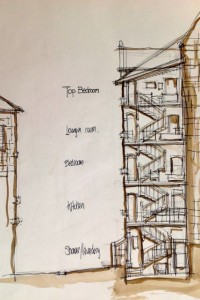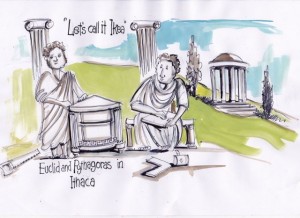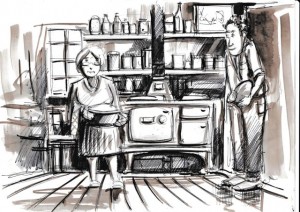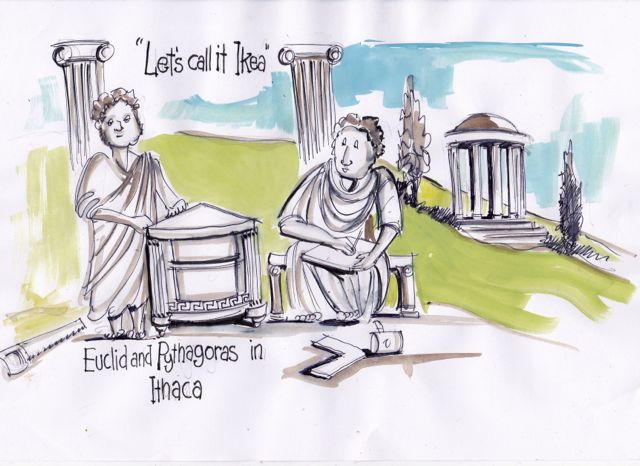The House within the Buttresses by Quentin Cockburn
 The house we stayed in at St Flour, (pronounced ‘Saint Fler’) is built within the buttresses of a 15th century church, almost a cathedral except it lacks the spire. Allegedly, (according to the brochure) this ‘house within the buttress’ was built during the French Revolution, and I suppose it was a terribly good way for the Girondists to say, ‘up yours’ to the conventions of church and state and the ancien regime and all that. Liberte, egalite, what better way than allowing high density within the exoskeleton of the church. Much the way the rhino or elephant is impervious to the tooki-tooki bird living off its arse, so this Church is impervious to this house. So, though I believe people were small back then, and this five rooms, on five floors is a wonder, a miracle of improvisation and execution. (I have a suggestion for the Melbourne Diocese regarding St Patricks, smaller parish churches in regional Victoria, and perhaps, (and at a pinch) the buttresses of Princes Bridge.)
The house we stayed in at St Flour, (pronounced ‘Saint Fler’) is built within the buttresses of a 15th century church, almost a cathedral except it lacks the spire. Allegedly, (according to the brochure) this ‘house within the buttress’ was built during the French Revolution, and I suppose it was a terribly good way for the Girondists to say, ‘up yours’ to the conventions of church and state and the ancien regime and all that. Liberte, egalite, what better way than allowing high density within the exoskeleton of the church. Much the way the rhino or elephant is impervious to the tooki-tooki bird living off its arse, so this Church is impervious to this house. So, though I believe people were small back then, and this five rooms, on five floors is a wonder, a miracle of improvisation and execution. (I have a suggestion for the Melbourne Diocese regarding St Patricks, smaller parish churches in regional Victoria, and perhaps, (and at a pinch) the buttresses of Princes Bridge.)
 The house has a very simple floor plan. There are five floors, the stairwell of about 3.5 mx 1.25 metres; connects all five. The stairs are very narrow with very high risers. The rooms are each about 3m x 4m, that’s about 12 square metres. Within the fabric of the structure, there are cupboards, bookshelves, and the odd niche, an ecclesiastical outline as the relief of one arch is stenciled into the rear facing wall. Why? Because it is an arch. The walls are plastered, and from within there’s this tremendous sense of security and comfort, (I wont mention saintliness). The windows and street-frontage are, (at the time I write) facing the sun, which illuminates the rooms gloriously, because of the lack of depth. We stayed there with the children, hardly ever saw them, until time for dinner. A vertically integrated house has so many natural advantages.
The house has a very simple floor plan. There are five floors, the stairwell of about 3.5 mx 1.25 metres; connects all five. The stairs are very narrow with very high risers. The rooms are each about 3m x 4m, that’s about 12 square metres. Within the fabric of the structure, there are cupboards, bookshelves, and the odd niche, an ecclesiastical outline as the relief of one arch is stenciled into the rear facing wall. Why? Because it is an arch. The walls are plastered, and from within there’s this tremendous sense of security and comfort, (I wont mention saintliness). The windows and street-frontage are, (at the time I write) facing the sun, which illuminates the rooms gloriously, because of the lack of depth. We stayed there with the children, hardly ever saw them, until time for dinner. A vertically integrated house has so many natural advantages.
If you have unwanted guests, just don’t answer the door, they’ll never ever hear you from the street. If you want to throw things, (our domestic situation invokes this) you have limited internal range, but extraordinary opportunities for hitting gargoyles on other rooftops, and if you’re having a row, you can isolate yourself to the top echelons an never come down.
There is no spillage, everything is isolated within its own niche. There is complete privacy, and you can tell when someone is lurking about by the creaking of the stairs. But unless anyone moves, the building itself is a silent as the grave (or the crypt).
Whilst in this house, I’d read a biography on Spike Milligan, and I think this house would have suited him. Where else could you be a self absorbed depressive, and, emerge extravert and visionary.
We watched as a group of architecture students held a mini tutorial in front of us, and the day we arrived St Flour held a big music festival in which people wandered round in quaint costume with Brueghellian era instruments, performing the French equivalent of Morris Dancing. What a coincidence I thought, and as the Jacobin said to the Prelate….what’s the reason ‘Qinc reason’!!, ‘Quelle reason’, ‘Cinq’ ( brief pause) Oh I thought you said sunk,. Oui, end of conversation..
Cheers
Quentin Cockburn



